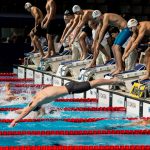The individual medley (IM) is a swimming event that combines all four competitive swimming strokes – butterfly, backstroke, breaststroke and freestyle – into one race. The order of the strokes is butterfly, backstroke, breaststroke and freestyle. The individual medley is an athletic test of speed, endurance and versatility as swimmers must master all four strokes.
The history of the individual medley
The individual medley has been a part of competitive swimming since the early 1900s, but it did not become an official Olympic event until the 1964 Tokyo Games. Prior to that, swimmers would often compete in unofficial 150-yard or 200-meter individual medley races.
The International Swimming Federation (FINA) officially recognized and standardized the event in 1952. FINA specified that the order would be butterfly, backstroke, breaststroke and freestyle. This remains the order that all individual medley races follow today.
Over the years, individual medley races have been added for various distances. The Olympic program currently includes the 200 meter and 400 meter individual medley events. There are also 100 meter, 150 yard, and 200 yard individual medleys in shorter course yards swimming.

How does an individual medley race work ?
In an individual medley race, each swimmer covers the four strokes in the specified order over the designated distance. Each stroke must cover one fourth of the total distance.
So in a 400 meter IM race, swimmers will swim 100 meters of butterfly, followed by 100 meters of backstroke, 100 meters of breaststroke, and finally 100 meters of freestyle. The swimmer is allowed only 15 meters of freestyle kicking underwater after the start and each turn before they must surface to swim.
The individual medley tests a swimmer’s proficiency, pace judgement and conditioning across all four strokes. Changing between strokes requires excellent body awareness, coordination and rhythm. The IM is considered one of the most challenging and demanding events in competitive swimming.
Butterfly in the individual medley
Butterfly is swum first in an IM race as it is the fastest stroke and allows swimmers to establish a quick pace. During the butterfly leg, swimmers must follow butterfly technique rules:
The body must be on the breast, with both shoulders in line with the water surface.
Both arms move simultaneously and symmetrically along with symmetrical dolphin kicks.
Each arm stroke brings the arm forward over the water, then back underwater.
The swimmer’s head must break the surface at least once per cycle.
Swimmers try to maintain a vigorous stroke tempo and limit unnecessary up-and-down movement or “bobbing.” Efficiency in the underwater kick is crucial for setting up the rest of the race.
Backstroke in the individual medley
The backstroke leg comes second in an individual medley race. On this portion, swimmers must follow backstroke technique rules:
The swimmer stays on the back with shoulders in line with the water surface.
Arm strokes are alternating and symmetrical with a fluttery underwater recovery.
Dolphin kicks are only allowed on the underwater recovery.
No somersaulting flips are allowed at the turns.
It takes coordination to transition from the prone butterfly to the supine backstroke. Getting in a strong underwater position off the wall is important. Backstroke specialists rely on their powerful underwater kick.

Breaststroke in the individual medley
After backstroke, swimmers move on to the breaststroke portion of the race. The technical rules for breaststroke include:
Body must be on the breast, shoulders in line with the water.
Arms move symmetrically together in a heart-shaped pattern.
Hands are pushed forward on recovery under the water.
Legs execute the whip kick – heels drawn up under the glutes on the kick.
The head must break the surface once per cycle.
Breaststroke requires concerted timing between the arm stroke and whip kick. Swimmers focus on strong extension and acceleration into each stroke while maintaining forward momentum.
Freestyle in the individual medley
Freestyle is swum last in an individual medley race. While technically swimmers can swim any stroke they want for this portion, most stick to front crawl. The freestyle rules state:
Swimmers must be on the breast, not the back, during freestyle.
Arm strokes alternate with over-water recovery.
The kick is usually a flutter kick, but dolphin kick is allowed.
At this point in the race, swimmers are often tired. They rely on efficient stroke length and explosive power from turns to maintain their speed to the finish.
Individual medley race strategy
To excel in the individual medley, swimmers must have proficient technique in all four strokes and understand how to race the event. Strategies include:
Going out fast in butterfly to get ahead.
Settling into a sustainable pace after the first 50 meters.
Building speed through each wall and turn.
Using underwater kicking to gain extra distance.
Adjusting tempo on breaststroke to avoid speed loss.
Sprinting hard using stroke length and kick on freestyle.
Judging effort and wall approaches to finish strong.
IM swimmers train for versatility to handle the demands of each segment. Effective pacing, transitions between strokes, underwater work, and conditioning are keys for individual medley success.
Conclusion
The individual medley is one of competitive swimming’s most rigorous tests. Mastering all four strokes takes tremendous skill and preparation. But swimmers who excel at the IM earn recognition as some of the world’s most complete athletes.


